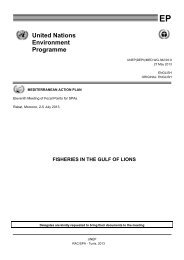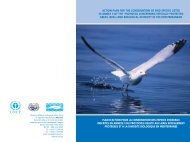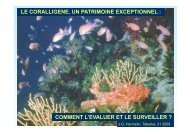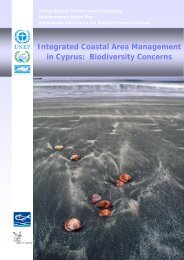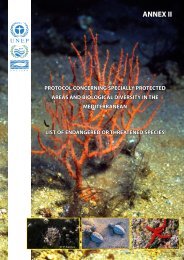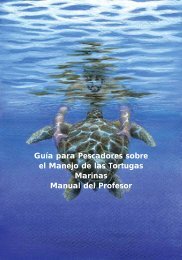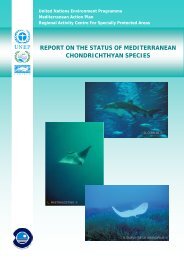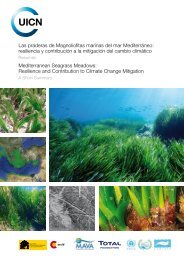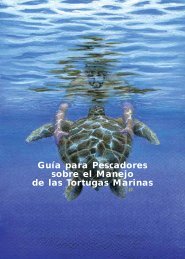Proceedings of the Second Mediterranean Symposium on Marine
Proceedings of the Second Mediterranean Symposium on Marine
Proceedings of the Second Mediterranean Symposium on Marine
You also want an ePaper? Increase the reach of your titles
YUMPU automatically turns print PDFs into web optimized ePapers that Google loves.
PROCEEDINGS OF THE SECOND MEDITERRANEAN SYMPOSIUM ON MARINE VEGETATION (ATHENS, 12-13 DECEMBER 2003)<br />
148<br />
Lithophyllum byssoides – formati<strong>on</strong> (“trottoir”): Present in places with high<br />
hydrodynamism and steep slope. The growth <str<strong>on</strong>g>of</str<strong>on</strong>g> Lithophyllum byssoides s<br />
creates an overhang in <str<strong>on</strong>g>the</str<strong>on</strong>g> upper infralittoral level that prevents <str<strong>on</strong>g>the</str<strong>on</strong>g><br />
growth <str<strong>on</strong>g>of</str<strong>on</strong>g> Cystoseira.<br />
Cystoseira spp. (sheltered envir<strong>on</strong>ments): Mainly characterized by Cystoseira crinita,<br />
C. brachycarpa, C. elegans but also by o<str<strong>on</strong>g>the</str<strong>on</strong>g>r species <str<strong>on</strong>g>of</str<strong>on</strong>g> <str<strong>on</strong>g>the</str<strong>on</strong>g> same genus.<br />
The same categories used for C. mediterranea can be used.<br />
Cystoseira compressa: Belt <str<strong>on</strong>g>of</str<strong>on</strong>g> Cystoseira compressa, it can also be distinguished in <str<strong>on</strong>g>the</str<strong>on</strong>g><br />
5 categories we have used for C. mediterranea / C. amentocea var. stricta.<br />
Posid<strong>on</strong>ia oceanica: Barrier reefs <str<strong>on</strong>g>of</str<strong>on</strong>g> Posid<strong>on</strong>ia oceanica, whose leaves attain <str<strong>on</strong>g>the</str<strong>on</strong>g> water<br />
surface can be observed in sheltered envir<strong>on</strong>ments, usually toge<str<strong>on</strong>g>the</str<strong>on</strong>g>r with<br />
Cystoseira spp.<br />
Cymodocea nodosa: Meadows dominated by this species in very sheltered<br />
envir<strong>on</strong>ments, over sand, mud or gravel.<br />
Zostera noltii: Meadows dominated by this species in extremely sheltered envir<strong>on</strong>ments,<br />
usually over muddy and silty bottoms.<br />
Corallina el<strong>on</strong>gata: This unit is characterized by <str<strong>on</strong>g>the</str<strong>on</strong>g> dominance <str<strong>on</strong>g>of</str<strong>on</strong>g> this species, which is<br />
widespread in <str<strong>on</strong>g>the</str<strong>on</strong>g> Northwestern <str<strong>on</strong>g>Mediterranean</str<strong>on</strong>g>, but always with <str<strong>on</strong>g>the</str<strong>on</strong>g> absence<br />
<str<strong>on</strong>g>of</str<strong>on</strong>g> Cystoseira. In fact, <str<strong>on</strong>g>the</str<strong>on</strong>g> categories 1 and 2 <str<strong>on</strong>g>of</str<strong>on</strong>g> Cystoseira should be usually<br />
attributed to this or o<str<strong>on</strong>g>the</str<strong>on</strong>g>r communities with <str<strong>on</strong>g>the</str<strong>on</strong>g> presence <str<strong>on</strong>g>of</str<strong>on</strong>g> some Cystoseira<br />
individuals.<br />
Haliptil<strong>on</strong> virgatum: Community dominated by this species, sometimes with Dictyota<br />
fasciola and Laurencia microcladia. Absence <str<strong>on</strong>g>of</str<strong>on</strong>g> Cystoseira plants.<br />
Mytilus galloprovincialis: Mussel beds, without Cystoseira.<br />
Green algae: Green littoral belts dominated by Ulva, Cladophora without Cystoseira.<br />
Encrusting corallines : Belts dominated by <str<strong>on</strong>g>the</str<strong>on</strong>g> encrusting corallines Lithophyllum<br />
incrustans, Neog<strong>on</strong>iolith<strong>on</strong> brassica-florida, and, even, crusts <str<strong>on</strong>g>of</str<strong>on</strong>g> Corallina<br />
el<strong>on</strong>gata.<br />
Blue green algae: The dominant species are blue green algae, perhaps with some<br />
ulvacean algae and Derbesia tenuissima.<br />
The presence/absence and abundance <str<strong>on</strong>g>of</str<strong>on</strong>g> every community is determined not <strong>on</strong>ly by<br />
polluti<strong>on</strong> or o<str<strong>on</strong>g>the</str<strong>on</strong>g>r antrhopogenic disturbances but also by <str<strong>on</strong>g>the</str<strong>on</strong>g> natural envir<strong>on</strong>ment.<br />
Therefore, different geomorphological parameters that most probably are involved in <str<strong>on</strong>g>the</str<strong>on</strong>g><br />
establishment and/or development <str<strong>on</strong>g>of</str<strong>on</strong>g> <str<strong>on</strong>g>the</str<strong>on</strong>g> communities have to be evaluated in order to<br />
account for this natural variability. The geomorphological factors that we have c<strong>on</strong>sidered<br />
are <str<strong>on</strong>g>the</str<strong>on</strong>g> following:<br />
- Coastline morphology: c<strong>on</strong>tinuous rock, blocks, st<strong>on</strong>es…<br />
- Substrate c<strong>on</strong>stituti<strong>on</strong>: calcareous, basaltic, granitic…<br />
- Coastline slope<br />
- Coastline orientati<strong>on</strong><br />
- Natural\Artificial<br />
- Degree <str<strong>on</strong>g>of</str<strong>on</strong>g> wave exposure<br />
- Height <str<strong>on</strong>g>of</str<strong>on</strong>g> <str<strong>on</strong>g>the</str<strong>on</strong>g> sea-cliffs




